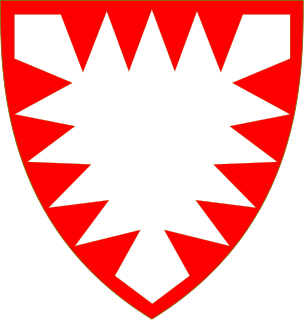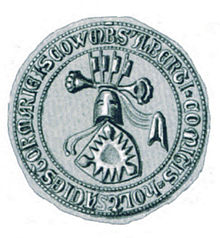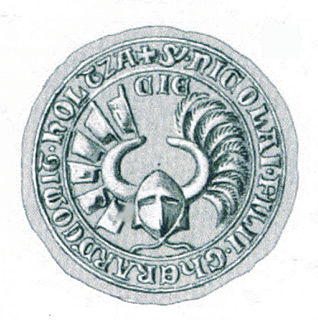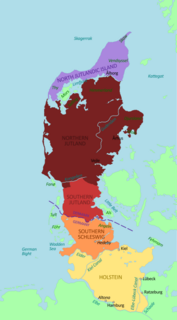
Albert I was a Duke of Saxony, Angria, and Westphalia; Lord of Nordalbingia; Count of Anhalt; and Prince-elector and Archmarshal of the Holy Roman Empire. Even though his grandfather Albert the Bear had held the Saxon dukedom between 1138 and 1142, this Albert is counted as the first.

Adolphus XI of Schauenburg, as Adolph I Duke of Schleswig, and as Adolph VIII Count of Holstein-Rendsburg, was the mightiest vassal of the Danish realm.

The House of Schaumburg was a dynasty of German rulers. Until c. 1485, it was also known as the House of Schauenburg. Together with its ancestral possession, the County of Schaumburg, the family also ruled the County of Holstein and its partitions Holstein-Itzehoe, Holstein-Kiel, Holstein-Pinneberg, Holstein-Plön, Holstein-Segeberg and Holstein-Rendsburg and through the latter at times also the Duchy of Schleswig.

Eric I of Saxe-Lauenburg (c.1280–1360) was a son of John I, Duke of Saxony, and Ingeborg Birgersdotter of Småland, a daughter or grandchild of Birger jarl. He ruled Saxony jointly with his uncle Albert II and his brothers Albert III and John II, first fostered by Albert II, until coming of age. In 1296 Eric, his brothers and their uncle divided Saxony into Saxe-Wittenberg, ruled by Albert II, and Saxe-Lauenburg, jointly ruled by the brothers between 1296 and 1303 and thereafter partitioned among them. Eric then ruled the branch duchy of Saxe-Ratzeburg-Lauenburg until 1338.
John II of Saxe-Lauenburg was the eldest son of John I of Saxony and Ingeborg Birgersdotter of Småland, a daughter or grandchild of Birger jarl. He ruled Saxony jointly with his uncle Albert II and his brothers Albert III and Eric I, first fostered by Albert II, until coming of age. In 1296 John II, his brothers and their uncle divided Saxony into Saxe-Wittenberg, ruled by Albert II, and Saxe-Lauenburg, jointly ruled by the brothers between 1296 and 1303 and thereafter partitioned among them. John II then ruled the branch duchy of Saxe-Mölln, later extended to become Saxe-Bergedorf-Mölln. In 1314 he officiated as Saxon Prince-elector in an election of a German king.
Albert III of Saxe-Lauenburg (1281–1308) was a son of John I, Duke of Saxony and Ingeborg Birgersdotter of Småland, a daughter or granddaughter of Birger Jarl. He ruled Saxony jointly with his uncle, Albert II, and his brothers Eric I and John II until their coming of age. In 1296 Albert III, his brothers and their uncle divided Saxony into Saxe-Wittenberg, ruled by Albert II, and Saxe-Lauenburg, jointly ruled by the brothers between 1296 and 1303 and thereafter partitioned among them. Albert III then ruled the branch duchy of Saxe-Ratzeburg until his death.
Eric V of Saxe-Lauenburg was a member of the House of Ascania; son of Duke Eric IV of Saxe-Lauenburg and Sophia of Brunswick-Lüneburg. Eric V and his brother John IV jointly succeeded their father in 1412 as dukes of Saxe-Lauenburg. After John IV had died in 1414, Eric ruled alone.

Bernard II of Saxe-Lauenburg was a member of the House of Ascania and Duke of Saxe-Lauenburg from 1426 to 1463. His full title was Duke of Saxony, Angria and Westphalia, however only ruling the branch duchy of Saxe-Lauenburg between 1426 and 1463.
Magnus II of Saxe-Lauenburg was the eldest surviving son of Duke Francis I of Saxe-Lauenburg and Sybille of Saxe-Freiberg, daughter of Duke Henry IV the Pious. In 1571 Magnus II ascended the throne after his father Francis I resigned due to indebtedness. Two years later Francis I, helped by his other son Francis (II), deposed Magnus II and re-ascended. Magnus' violent and judicial attempts to regain the duchy failed. In 1588 he was imprisoned for the remainder of his life.

Francis II of Saxe-Lauenburg, was the third son of Francis I of Saxe-Lauenburg and Sybille of Saxe-Freiberg, daughter of Duke Henry IV the Pious of Saxony. From 1581 on he ruled Saxe-Lauenburg as duke.

Gerhard VI was the Count of Holstein-Rendsburg from 1382, and Duke of Schleswig as of 1386.

Gerhard I, Count of Holstein-Itzehoe was the only count of Holstein-Itzehoe.

John I, Count of Holstein-Kiel was a member of the House of Schauenburg. He was Count of Holstein-Kiel from 1261 until his death.














